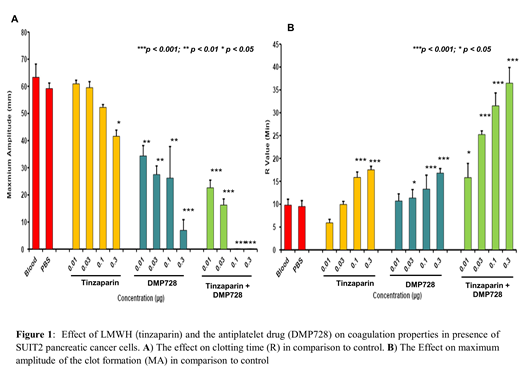Introduction: Therapeutic options for the management of venous thromboembolism (VTE) in patients with cancer remain very limited. Although low-molecular-weight heparin (LMWH) monotherapy has been identified as a simple and efficacious regimen. However, treatment of patients with a high risk of bleeding as well as the treatment of recurrent VTE with dose escalation of LMWH, and management in patients with thrombocytopenia represent major challenges.
On the other side, Platelet activation is the first response to tissue damage and, may promote chronic inflammation-related cancer, mainly through the release of soluble factors and vesicles that are rich in genetic materials and proteins. Platelets also sustain cancer cell invasion and metastasis formation by fostering the development of the epithelial-mesenchymal transition phenotype, cancer cell survival in the bloodstream and arrest/extravasation at the endothelium. Furthermore, platelets contribute to tumor escape from immune elimination.
Hence, we examined the effect of combined lose doses of the LMWH tinzaparin and the antiplatelet GPIIb/IIIa antagonist DMP728 on cancer associated thrombosis (CAT) using thrombelastogrphy. DMP728 is used for inhibiting the binding of Platelet GPIIb/IIIa. Glycoprotein IIb/IIIa is a receptor for fibrin and leads to further the activation of platelets to form blood clots.
Aim: To determine the effects of tinzaparin and/or DMP728 on platelet/fibrin clot kinetics using thrombelastography (TEG) in presence or absence of pancreatic cancer cells (SUIT2) that expresses tissue factor.
Methods: Human blood collected from healthy volunteers in sodium citrate tubes and treated with different concentrations (0.01, 0.03, 0.1 and 0.3 μg) of Tinzaparin, DMP 728, and/or tinzaparin + DMP728 in presence or absence of pancreatic cancer cells (SUIT 2 cells). We compared the effects on the coagulation time, time to clot initiation and thrombus strength level in vitro.
Results: In the absence of SUIT 2 pancreatic cancer cells, thrombelastographic (TEG) have shown that, increasing concentrations of tinzaparin and DMP728 (0.01 - 0.3 μg) were associated with marked increased clotting time (R) and decreased maximum amplitude of the clot formation (MA) in comparison to control. After adding the SUIT 2 pancreatic cancer cells to human blood, shortened the time to clot initiation (R) and increased the clot strength (MA) have been observed.
In presence of SUIT2 Pancreatic Cancer Cell, tinzaparin was associated with increased clotting time (R) and decreased maximum amplitude of the clot formation (MA) in comparison to control. However, DMP728 R Value has not shown much effect on clotting time (R) and maximum amplitude of the clot formation (MA). A combination of DMP728 and tinzaparin was associated with a greater synergistic Increase in clotting time (R), with a synergistic decrease in maximum amplitude of the clot formation (MA) (Figure 1).
Conclusions: The combination of the LMWH (tinzaparin) and the antiplatelet drug (DMP728) might be a successful approach in the prevention and treatment of cancer associated thrombosis.
No relevant conflicts of interest to declare.
Author notes
Asterisk with author names denotes non-ASH members.


This feature is available to Subscribers Only
Sign In or Create an Account Close Modal